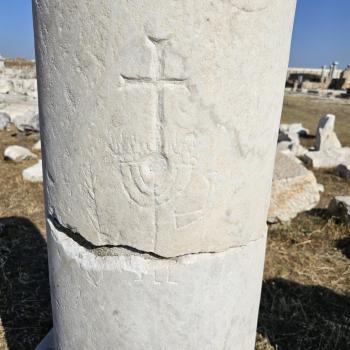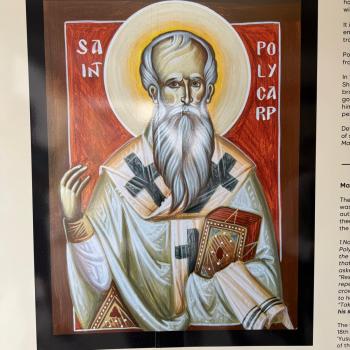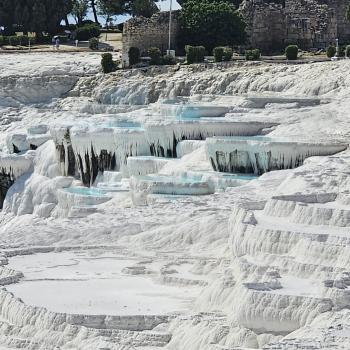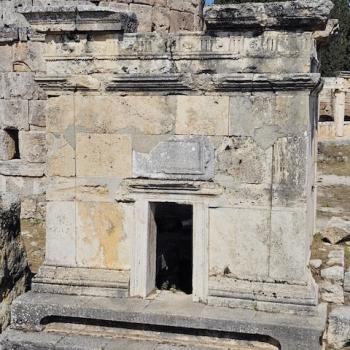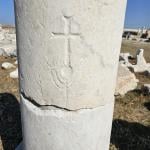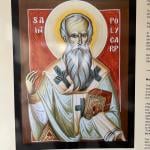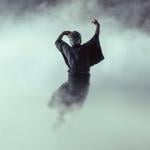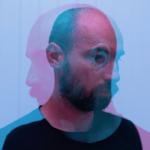 On a cliff overlooking the vast Black Sea stands Hagia Sophia Church. No not the more famous one in Istanbul, but rather its baby sister, so to speak. One of the last things Mark Fairchild and I did before going to the Ephesus meeting and lecturing was visit this church. You never know what to expect, but as it turns out, this church is spectacular. Like all such churches in Turkey which are in good shape, it is a museum today. Part of the history many will not know is that while these churches began life as Greek Orthodox churches, during WWII when there was a Russian presence in Turkey they became Russian Orthodox Churches, and then with the rise of Ataturk they ceased to be functioning churches at all. One reason was the act of repatriation of many Greeks back to Greece in the 1920s, a sad and shameful tale in Turkish history frankly. The church is built largely on a Romanesque plan with a central tower and its frescoes and mosaics are wonderful. The first picture below is of the back of the church which is actually the front of the church with the baptismal font in the foreground. The next picture is of the view of the Black sea from the back of the garden which overlooks the sea. Following that is a view of the side door into the chapel in the apse seen through a hole in an ancient olive tree.
On a cliff overlooking the vast Black Sea stands Hagia Sophia Church. No not the more famous one in Istanbul, but rather its baby sister, so to speak. One of the last things Mark Fairchild and I did before going to the Ephesus meeting and lecturing was visit this church. You never know what to expect, but as it turns out, this church is spectacular. Like all such churches in Turkey which are in good shape, it is a museum today. Part of the history many will not know is that while these churches began life as Greek Orthodox churches, during WWII when there was a Russian presence in Turkey they became Russian Orthodox Churches, and then with the rise of Ataturk they ceased to be functioning churches at all. One reason was the act of repatriation of many Greeks back to Greece in the 1920s, a sad and shameful tale in Turkish history frankly. The church is built largely on a Romanesque plan with a central tower and its frescoes and mosaics are wonderful. The first picture below is of the back of the church which is actually the front of the church with the baptismal font in the foreground. The next picture is of the view of the Black sea from the back of the garden which overlooks the sea. Following that is a view of the side door into the chapel in the apse seen through a hole in an ancient olive tree.
The mosaic floor under the central dome is interesting.

 The main reason of course to take pictures in this church is all the wall paintings or frescoes of various Biblical scenes and of saints.
The main reason of course to take pictures in this church is all the wall paintings or frescoes of various Biblical scenes and of saints.
 What normally has happened in these Christian buildings is that at some point after they were abandoned they have been defaced due to the anti-iconic nature of Islamic faith— no graven images of God for sure, or saints for that matter. One of the most remarkable exceptions to this rule is in the Mohammed Ali mosque in Cairo (the source of the name of the American boxer by the way) which until recently had a picture of President Mubarak in it. This Hagia Sophia has suffered very little damage from defacing, which seems to have happened less in the 20th century than in earlier centuries when Muslims took over Christian sites.
What normally has happened in these Christian buildings is that at some point after they were abandoned they have been defaced due to the anti-iconic nature of Islamic faith— no graven images of God for sure, or saints for that matter. One of the most remarkable exceptions to this rule is in the Mohammed Ali mosque in Cairo (the source of the name of the American boxer by the way) which until recently had a picture of President Mubarak in it. This Hagia Sophia has suffered very little damage from defacing, which seems to have happened less in the 20th century than in earlier centuries when Muslims took over Christian sites. 

 The third picture here is an interesting rendering of the six winged seraphs from Isaiah 6 combined with the throne chariot vision as John saw it in Revelation 4.
The third picture here is an interesting rendering of the six winged seraphs from Isaiah 6 combined with the throne chariot vision as John saw it in Revelation 4. 
 There are a variety of archaeological works lying about in the courtyard of this church and we will have occasion to talk about the most important one in a post about Satala later, but for now I leave you with a typical orthodox shrine. Shrines are set up in Greece and elsewhere to remember the spot where some believer met an untimely end, and so you will see them on the side of the road in Greece where there are hairpin turns etc. The shrine itself usually contains a candle and perhaps a picture of the deceased and some oil if there is an oil lamp in it. Here are a couple of such shrines.
There are a variety of archaeological works lying about in the courtyard of this church and we will have occasion to talk about the most important one in a post about Satala later, but for now I leave you with a typical orthodox shrine. Shrines are set up in Greece and elsewhere to remember the spot where some believer met an untimely end, and so you will see them on the side of the road in Greece where there are hairpin turns etc. The shrine itself usually contains a candle and perhaps a picture of the deceased and some oil if there is an oil lamp in it. Here are a couple of such shrines.  They tend to look like over-sized bird houses. In our next post we will talk about what some have called the third most famous Greek orthodox monastery in the world— the Sumela monastery nestled safely today in a national park about an hour south of Trabzon.
They tend to look like over-sized bird houses. In our next post we will talk about what some have called the third most famous Greek orthodox monastery in the world— the Sumela monastery nestled safely today in a national park about an hour south of Trabzon.







